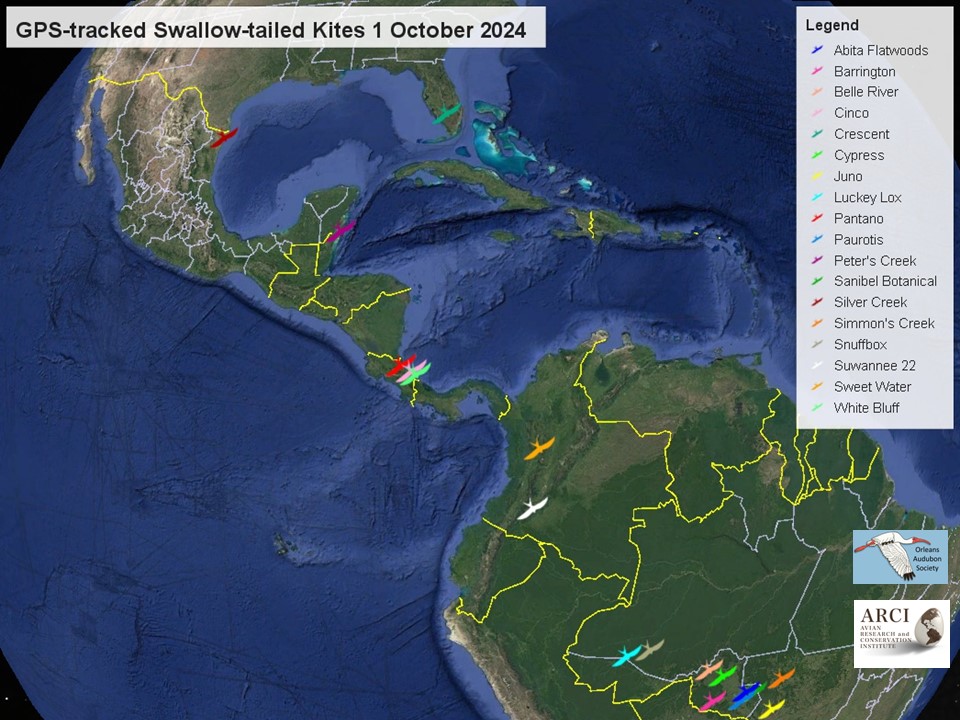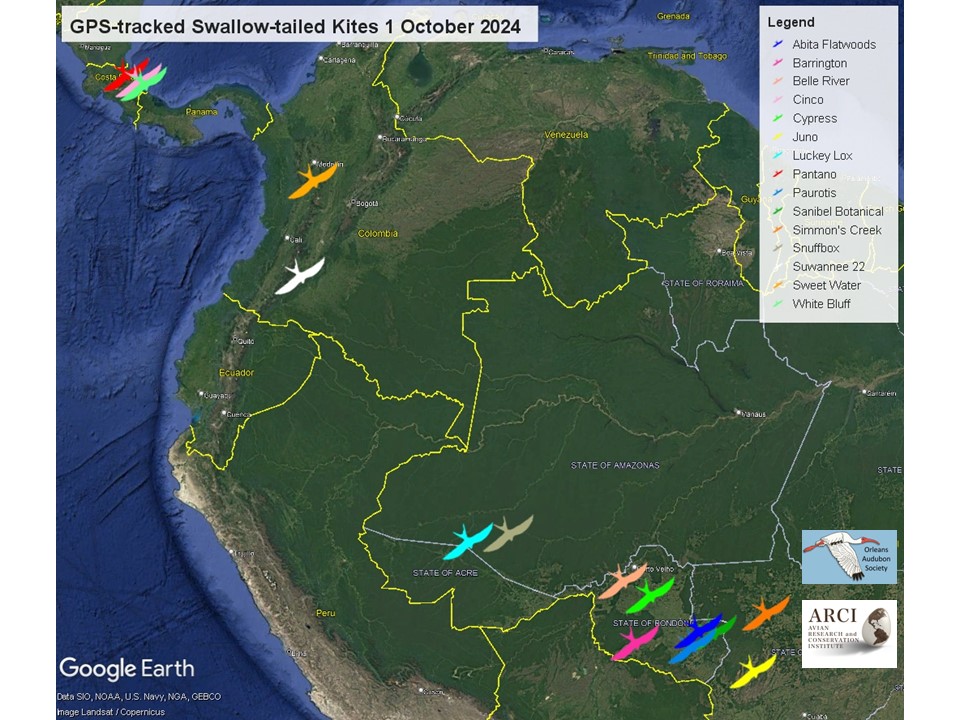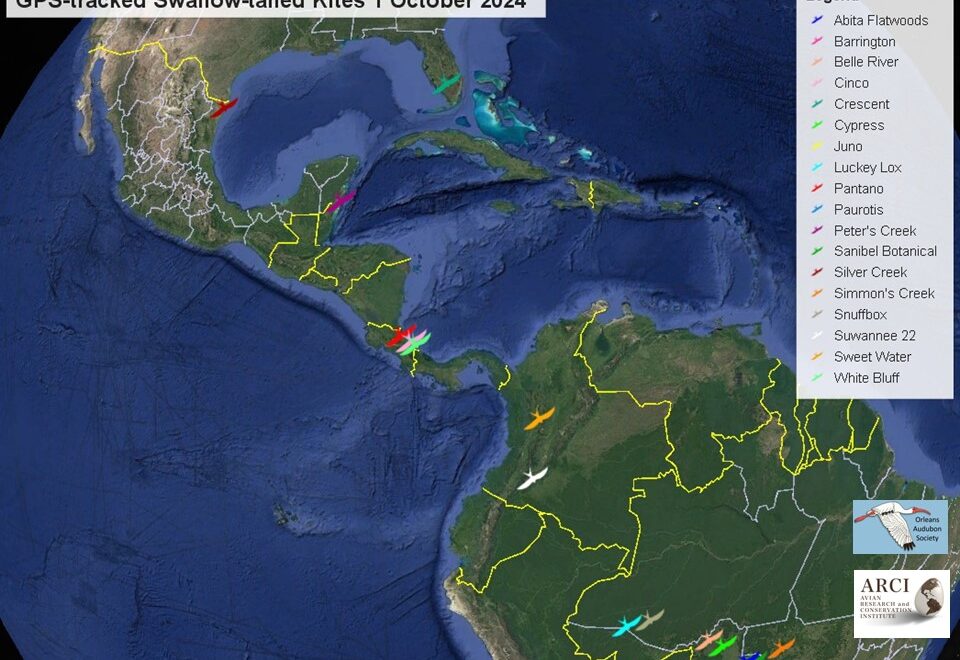The following update includes 14 GPS-tracked Swallow-tailed Kites ARCI has tagged in Florida, Georgia, and South Carolina as well as four Kites tagged by our partners at Orleans Audubon Society in Louisiana and Mississippi, all through various projects, partnerships, and funding.
The order of Swallow-tailed Kite updates are listed from the order of their tagging location starting in South Carolina, south and west to Louisiana. Some of these birds have not uploaded data for almost 60 days! Most of these Kites are being tracked with the GSM-cellular network so when they are not near cell towers, they cannot upload their data. They only attempt to upload their data once a day to save battery on their solar powered units (by CTT) and during these big stretches over mountains, rainforest and vast wilderness, they are far from a cellular connection. We hope that is the case with our missing birds and that once they reach a place with cell coverage, they will be able to connect and upload all their location data.

Simmon’s Creek, a male from Georgetown County, South Carolina is one of the Swallow-tailed Kites that is the farthest south, now in the State of Mato Grosso, Brazil.
Peter’s Creek, a male from Georgetown County, South Carolina was the last of the GPS-tracked Swallow-tailed Kites to cross the Gulf of Mexico. We tracked him through Quintana Roo, Mexico and that is where he last checked in in mid-September.
Sweet Water, a female from Burke County, Georgia was “missing” from data uploads for over a month and recently checked in from the Andes Mountains in Colombia.
Crescent, a female from Jasper County, South Carolina was last in south Florida on 1 August and has not uploaded data since. We will remain optimistic that she will get to an area with cell coverage soon to upload her data.
Snuffbox Canal, a male from McIntosh County, Georgia is in the State of Amazonas, Brazil.
Barrington, a male from McIntosh County, Georgia is in the State of Rondônia, Brazil.
Juno, a female from Palm Beach County, Florida is the farthest south Swallow-tailed Kites in the State of Mato Grosso, Brazil.
Cypress, a male from Palm Beach County, Florida is in the State of Rondônia, Brazil.
Luckey Lox, a female from Palm Beach County, Florida is in the State of Amazonas, Brazil.
Pantano, a female from Palm Beach County, Florida is one of three kites we have not had signal from since they were last in Costa Rica in August (with Cinco and White Bluff).
Cinco, a female from the Florida Panther National Wildlife Refuge Florida is one of three kites we have not had signal from since they were last in Costa Rica in August (with Pantano and White Bluff).
Paurotis, a female from the Florida Panther National Wildlife Refuge has made her way to the State of Rondônia, Brazil quite close to Sanibel Botanical and Abita Flatwoods.
Sanibel Botanical, a female from Lee County, Florida has made her way to the State of Rondônia, Brazil quite close to Paurotis and Abita Flatwoods.
Suwannee 22, a female from the Lower Suwannee National Wildlife Refuge in Levy County, Florida is our news-worthy Swallow-tailed Kite that had a second chance at crossing the Gulf of Mexico after Hurricane Debby. She has crossed the Andes in Colombia and continues south.
The Silver Creek a juvenile female released in Marion County, Mississippi, finally left the grasshopper hot spot on the Red River near Sivells Bend, Texas, to migrate: a cold front that passed through on September 25 probably urged her along. She headed south and made it to the Gulf Coast late on September 27 to spend the night near San Antonio Bay, Texas. Three Swallow-tailed Kites were observed on September 28 on the Hazel Bazemore Park Hawkwatch, but she was probably not one of them because she flew very close to the coast when departing her roost site. From here she followed the coast, flying over land to roost 25 miles south of Matamoros, Mexico, on the night of September 29.
Belle River, a female tagged in Assumption Parish, Louisiana crossed the Andes Mountains between Pereira and Tulua, Colombia on August 25. She then crossed into Brazil on September 11 in the State of Amazonas. She proceeded to the Madeira River and spent one week hunting there west of Porto Velho. Then, surprisingly, she reversed her track, flying northwest across the State of Amazonas for 145 miles to where she is now hunting on the Reserva Extrativista do Medio Purus along the Purus River in the State of Amazonas, Brazil.
The Abita Flatwoods female, from St. Tammany Parish, Louisiana is in the Brazilian State of Rondônia quite close to Sanibel Botanical and Paurotis.
The whereabouts of the White Bluff male from Marion County, Mississippi, are not known because his transmitter has not checked in recently. His last known location was near Limon, Costa Rica, on August 31 (near Cinco and Pantano’s last know locations).
ARCI and OAS are tracking Swallow-tailed Kites not only to monitor the roosts, foraging areas, stopover sites, and winter destinations, but also to see how they use public and private lands throughout the Southeastern States. We are grateful for our funders and project partners for making this research possible. Please see previous blog posts with background and project partners for each Swallow-tailed Kite.



Leave a Reply